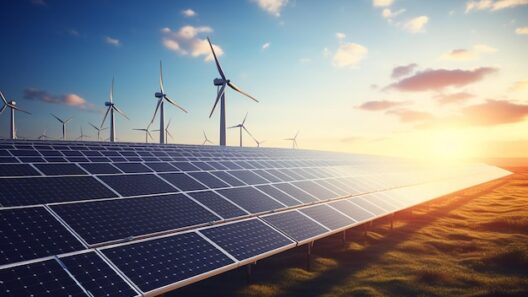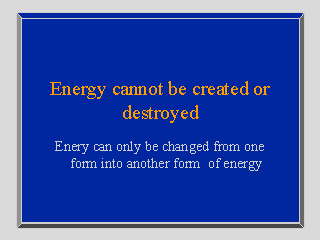The Law of Conservation of Energy is a fundamental principle in physics, epitomizing the immutable nature of energy within our universe. This guiding tenet asserts that energy cannot be created or destroyed; it can only be transformed from one form to another. In a world teeming with transformation, understanding this law provides clarity, not just within the realms of science but also in the intricate tapestry of our daily lives and the environment we inhabit.
In simplicity, the law serves as a reminder—a custodian of balance. It means that the energy present in any isolated system remains constant; it merely shifts shapes, much like a chameleon adapting to its surroundings. However, the implications are profound, influencing everything from the ecological footprints we leave to the innovative technologies we employ in a quest for sustainability. This article decodes the essence of the Law of Conservation of Energy, illustrating its principles and far-reaching influence.
Understanding Energy: Definitions and Forms
Energy manifests in various forms, each with unique properties and functions. The most recognizable forms include kinetic energy—energy in motion, potential energy—stored energy, thermal energy—related to temperature and heat, and chemical energy—stored within the bonds of molecules. This diversity in energy types allows for the dynamic interplay within systems, whether it’s the swirling of leaves in the wind or the flickering flame of a candle.
To grasp the significance of the conservation principle, one must appreciate how these forms transfer and transform. For instance, when fossil fuels are combusted, the chemical energy stored within the fuels morphs into thermal energy, which can then be converted into electrical energy to power our homes. Herein lies an essential takeaway: energy is never ‘lost’; it is reconstituted, recycled, perpetually engaged in the dance of life.
The Flaws of Misconception: Breaking Myths
Through discussions surrounding energy, misconceptions abound. A prevalent myth is that energy is ‘consumed’ in processes. In reality, energy is merely converted. This transformation can often lead to a degree of inefficiency, illustrated by the heat emitted from cars or appliances—a byproduct of energy transitioning through various forms rather than a loss. In an environmental context, understanding these inefficiencies prompts a call to action for improved technologies and renewable resources that align with the conservation principle.
Another misconception presents itself in the notion of infinite sources. Renewable energies, such as wind and solar, offer a sustainable approach, but even these are bound by the laws of thermodynamics and conservation. The sun, for instance, supplies energy to Earth, but it does so within finite limits. Savvy utilization of these resources hinges on our ability to harness and convert them effectively, maximizing the energy they provide while minimizing waste.
The Ripple Effect: Impacts on Ecological Systems
The application of the Law of Conservation of Energy extends beyond mere physics; it reverberates through ecological systems, profoundly affecting ecosystems and biodiversity. Consider the food web, wherein energy is transferred from one organism to another, initiating a cascade of transformations. Plants capture sunlight through photosynthesis, converting solar energy into chemical energy stored in their tissues. Herbivores then consume these plants, transferring energy through the trophic levels, albeit with efficiency losses at each step.
This flow accentuates the importance of energy efficiency in ecosystems. Each interaction exemplifies the conservation principle; energy shifts in form and location, sustaining countless forms of life. A nuanced understanding of these dynamics is pivotal for environmental conservation, as it underscores why perturbations in one part of an ecosystem can reverberate through the entire system, often with unforeseen consequences.
Innovations in Energy Conservation: The Future Beckons
As we strive to mitigate climate change and reduce our reliance on fossil fuels, innovations rooted in the Law of Conservation of Energy promise transformative potential. Advances in energy technology, such as energy storage systems, smart grid solutions, and energy-efficient appliances, embody the principle of energy transformation and utilization.
For instance, the burgeoning field of renewable energy storage aims to address intermittent energy supply issues by converting and storing energy captured during peak sunlight hours for use later, thus optimizing the availability of renewable sources.
This technological pivot is not merely a matter of convenience; it represents a profound adherence to the conservation law, ensuring that every joule of energy generated is utilized to its fullest potential, thereby minimizing waste. In doing so, we acknowledge our role as stewards of energy, tasked with both harnessing and conserving the bounty our planet offers.
Embedding Conservation in Our Lives: A Cultural Shift
Energy conservation extends beyond technology; it encompasses cultural and behavioral shifts. The choices individuals make on a daily basis—from turning off lights when leaving a room to opting for public transportation—can collectively contribute to a significant reduction in energy consumption. This cultural shift toward awareness of energy conservation practices is vital in fostering sustainable habits that resonate across generations.
Moreover, education plays a crucial role in nurturing a consciousness of energy conservation. Engaging communities in discussions around the conservation law not only amplifies understanding but also empowers citizens to partake in eco-conscious practices and policies that prioritize sustainability. The more individuals comprehend the intricacies of energy transformation, the more likely they are to champion change—both personally and collectively.
In conclusion, the Law of Conservation of Energy is more than a mere scientific principle; it is an elegantly woven narrative of our universe, guiding our actions and informing our choices. By decoding its key principles and recognizing its widespread implications—from ecological systems to our reliance on innovation—we illuminate the path toward a sustainable future. The dance of energy continues, and it is incumbent upon us to waltz gracefully, ensuring the conservation of our invaluable resources for generations to come.





